radio FORD TRANSIT 2006 7.G Body And Equipment Mounting Section Manual
[x] Cancel search | Manufacturer: FORD, Model Year: 2006, Model line: TRANSIT, Model: FORD TRANSIT 2006 7.GPages: 234, PDF Size: 33.19 MB
Page 4 of 234
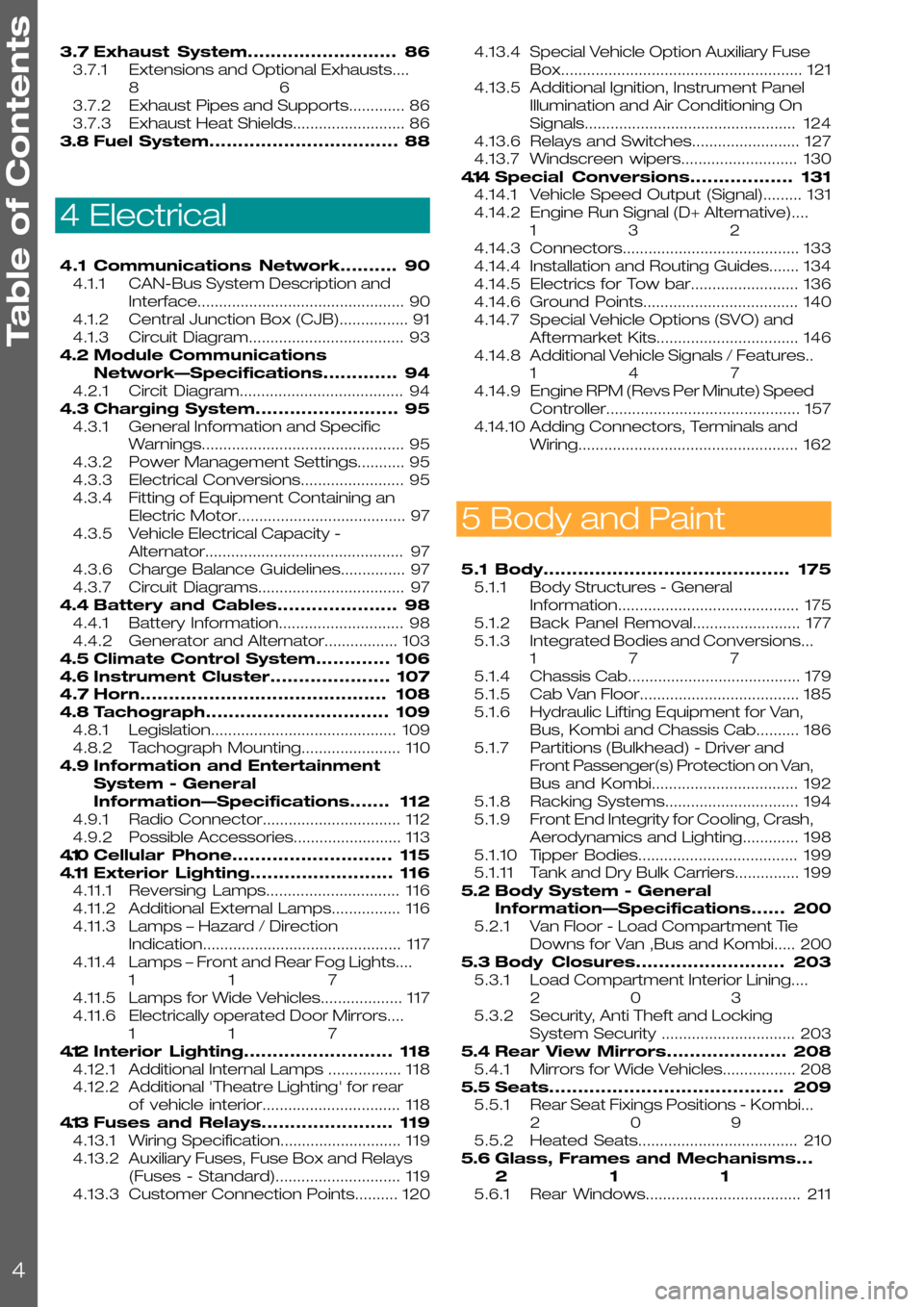
3.7Exhaust System..........................86
3.7.1Extensions and Optional Exhausts....
86
3.7.2Exhaust Pipes and Supports.............86
3.7.3Exhaust Heat Shields..........................86
3.8Fuel System.................................88
4 Electrical
4.1Communications Network..........90
4.1.1CAN-Bus System Description and
Interface................................................90
4.1.2Central Junction Box (CJB)................91
4.1.3Circuit Diagram....................................93
4.2Module Communications
Network—Specifications.............94
4.2.1Circit Diagram......................................94
4.3Charging System.........................95
4.3.1General Information and Specific
Warnings...............................................95
4.3.2Power Management Settings...........95
4.3.3Electrical Conversions........................95
4.3.4Fitting of Equipment Containing an
Electric Motor.......................................97
4.3.5Vehicle Electrical Capacity -
Alternator..............................................97
4.3.6Charge Balance Guidelines...............97
4.3.7Circuit Diagrams..................................97
4.4Battery and Cables.....................98
4.4.1Battery Information.............................98
4.4.2Generator and Alternator.................103
4.5Climate Control System.............106
4.6Instrument Cluster.....................107
4.7Horn...........................................108
4.8Tachograph................................109
4.8.1Legislation...........................................109
4.8.2Tachograph Mounting.......................110
4.9Information and Entertainment
System - General
Information—Specifications.......112
4.9.1Radio Connector................................112
4.9.2Possible Accessories.........................113
4.10Cellular Phone............................115
4.11Exterior Lighting.........................116
4.11.1Reversing Lamps...............................116
4.11.2Additional External Lamps................116
4.11.3Lamps – Hazard / Direction
Indication..............................................117
4.11.4Lamps – Front and Rear Fog Lights....
117
4.11.5Lamps for Wide Vehicles...................117
4.11.6Electrically operated Door Mirrors....
117
4.12Interior Lighting..........................118
4.12.1Additional Internal Lamps .................118
4.12.2Additional 'Theatre Lighting' for rear
of vehicle interior................................118
4.13Fuses and Relays.......................119
4.13.1Wiring Specification............................119
4.13.2Auxiliary Fuses, Fuse Box and Relays
(Fuses - Standard).............................119
4.13.3Customer Connection Points..........120
4.13.4Special Vehicle Option Auxiliary Fuse
Box........................................................121
4.13.5Additional Ignition, Instrument Panel
Illumination and Air Conditioning On
Signals.................................................124
4.13.6Relays and Switches.........................127
4.13.7Windscreen wipers...........................130
4.14Special Conversions..................131
4.14.1Vehicle Speed Output (Signal).........131
4.14.2Engine Run Signal (D+ Alternative)....
132
4.14.3Connectors.........................................133
4.14.4Installation and Routing Guides.......134
4.14.5Electrics for Tow bar.........................136
4.14.6Ground Points....................................140
4.14.7Special Vehicle Options (SVO) and
Aftermarket Kits.................................146
4.14.8Additional Vehicle Signals / Features..
147
4.14.9Engine RPM (Revs Per Minute) Speed
Controller.............................................157
4.14.10Adding Connectors, Terminals and
Wiring...................................................162
5 Body and Paint
5.1Body...........................................175
5.1.1Body Structures - General
Information..........................................175
5.1.2Back Panel Removal.........................177
5.1.3Integrated Bodies and Conversions...
177
5.1.4Chassis Cab........................................179
5.1.5Cab Van Floor.....................................185
5.1.6Hydraulic Lifting Equipment for Van,
Bus, Kombi and Chassis Cab..........186
5.1.7Partitions (Bulkhead) - Driver and
Front Passenger(s) Protection on Van,
Bus and Kombi..................................192
5.1.8Racking Systems...............................194
5.1.9Front End Integrity for Cooling, Crash,
Aerodynamics and Lighting.............198
5.1.10Tipper Bodies.....................................199
5.1.11Tank and Dry Bulk Carriers...............199
5.2Body System - General
Information—Specifications......200
5.2.1Van Floor - Load Compartment Tie
Downs for Van ,Bus and Kombi.....200
5.3Body Closures..........................203
5.3.1Load Compartment Interior Lining....
203
5.3.2Security, Anti Theft and Locking
System Security ...............................203
5.4Rear View Mirrors.....................208
5.4.1Mirrors for Wide Vehicles.................208
5.5Seats.........................................209
5.5.1Rear Seat Fixings Positions - Kombi...
209
5.5.2Heated Seats.....................................210
5.6Glass, Frames and Mechanisms...
211
5.6.1Rear Windows....................................211
Table of Contents
4
Page 24 of 234
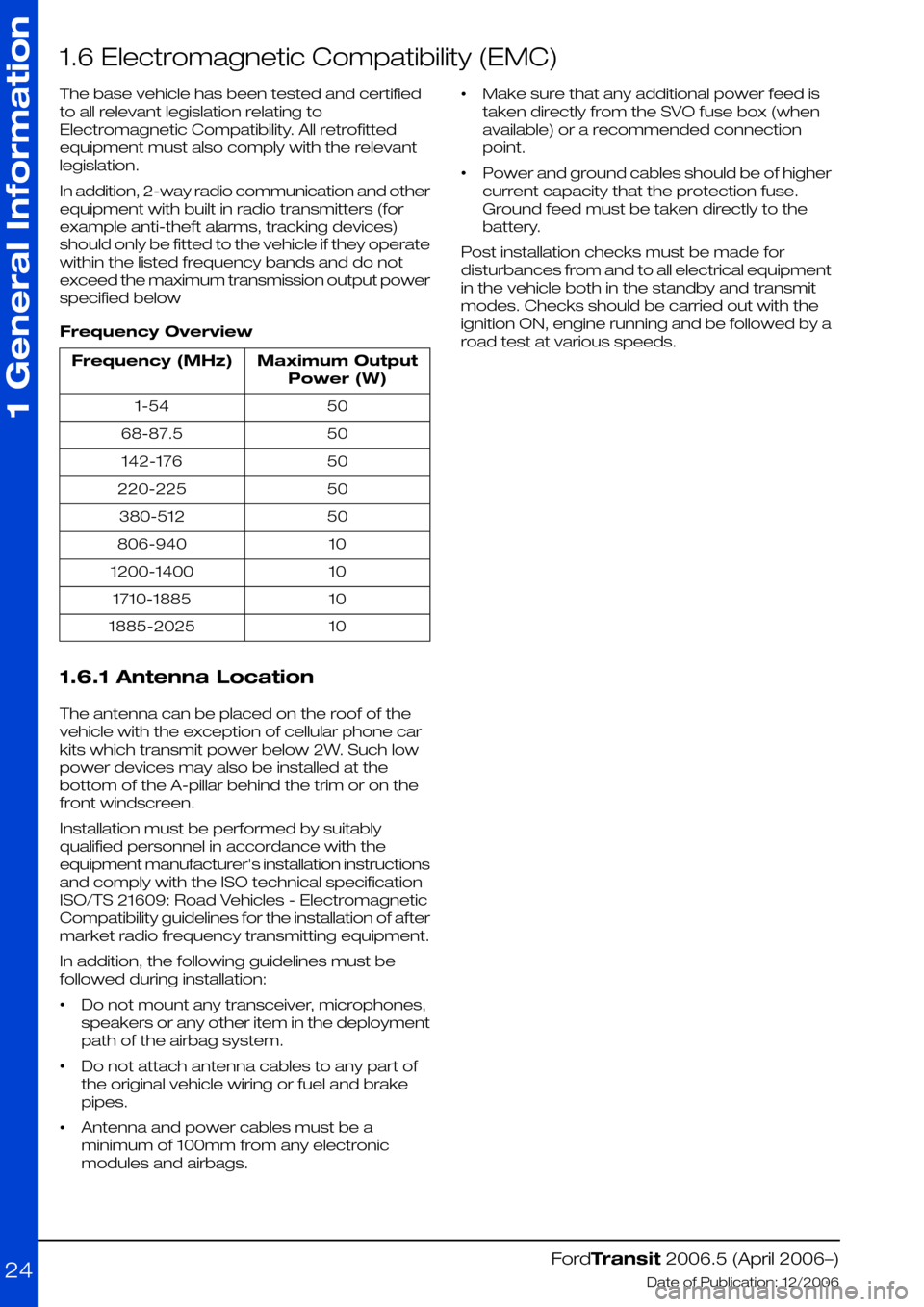
1.6 Electromagnetic Compatibility (EMC)
The base vehicle has been tested and certified
to all relevant legislation relating to
Electromagnetic Compatibility. All retrofitted
equipment must also comply with the relevant
legislation.
In addition, 2-way radio communication and other
equipment with built in radio transmitters (for
example anti-theft alarms, tracking devices)
should only be fitted to the vehicle if they operate
within the listed frequency bands and do not
exceed the maximum transmission output power
specified below
Frequency Overview
Maximum Output
Power (W)
Frequency (MHz)
501-54
5068-87.5
50142-176
50220-225
50380-512
10806-940
101200-1400
101710-1885
101885-2025
1.6.1 Antenna Location
The antenna can be placed on the roof of the
vehicle with the exception of cellular phone car
kits which transmit power below 2W. Such low
power devices may also be installed at the
bottom of the A-pillar behind the trim or on the
front windscreen.
Installation must be performed by suitably
qualified personnel in accordance with the
equipment manufacturer's installation instructions
and comply with the ISO technical specification
ISO/TS 21609: Road Vehicles - Electromagnetic
Compatibility guidelines for the installation of after
market radio frequency transmitting equipment.
In addition, the following guidelines must be
followed during installation:
•Do not mount any transceiver, microphones,
speakers or any other item in the deployment
path of the airbag system.
•Do not attach antenna cables to any part of
the original vehicle wiring or fuel and brake
pipes.
•Antenna and power cables must be a
minimum of 100mm from any electronic
modules and airbags.
•Make sure that any additional power feed is
taken directly from the SVO fuse box (when
available) or a recommended connection
point.
•Power and ground cables should be of higher
current capacity that the protection fuse.
Ground feed must be taken directly to the
battery.
Post installation checks must be made for
disturbances from and to all electrical equipment
in the vehicle both in the standby and transmit
modes. Checks should be carried out with the
ignition ON, engine running and be followed by a
road test at various speeds.
FordTransit 2006.5 (April 2006–)
Date of Publication: 12/2006
1 General Information
24
Page 91 of 234
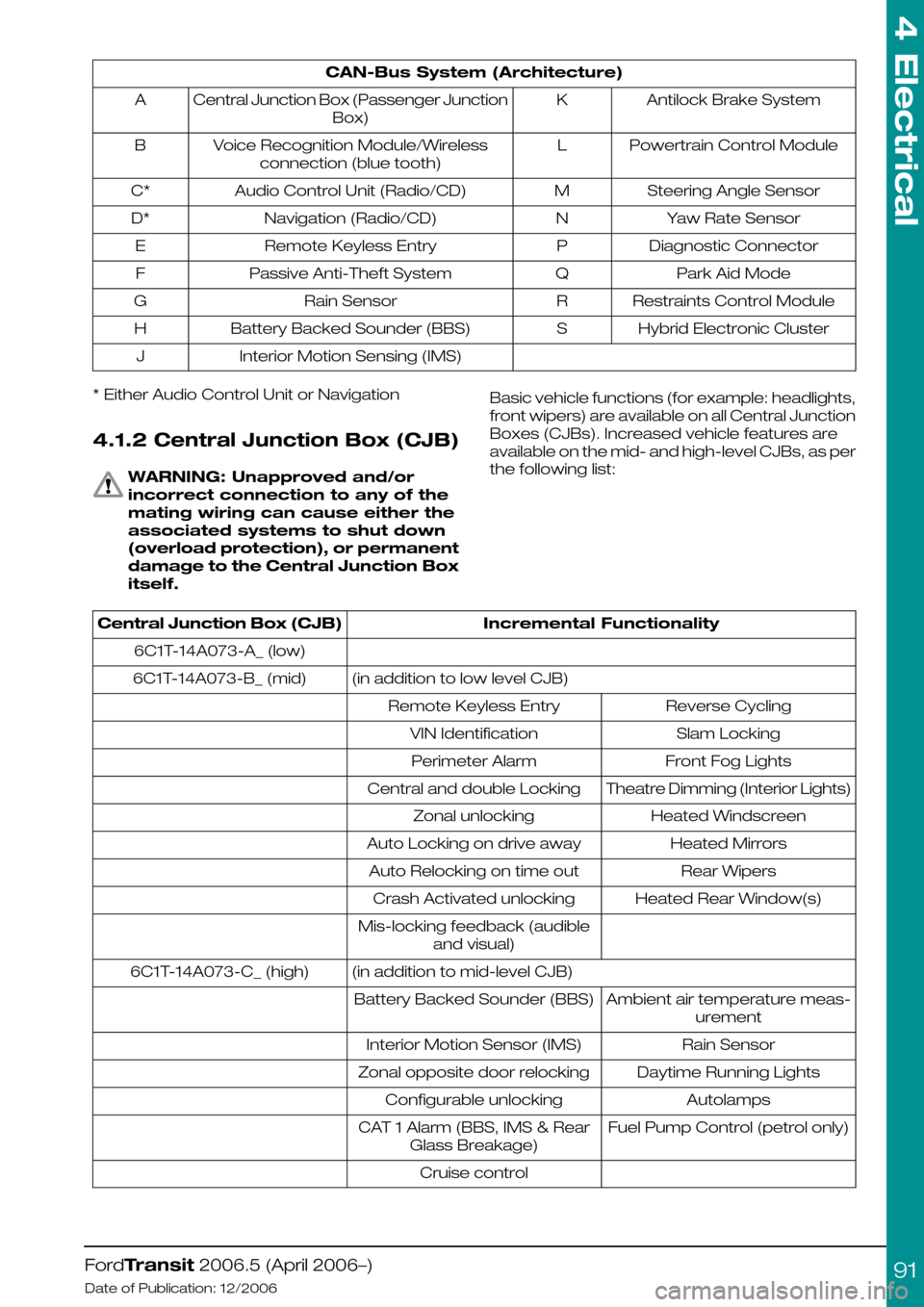
CAN-Bus System (Architecture)
Antilock Brake SystemKCentral Junction Box (Passenger Junction
Box)
A
Powertrain Control ModuleLVoice Recognition Module/Wireless
connection (blue tooth)
B
Steering Angle SensorMAudio Control Unit (Radio/CD)C*
Yaw Rate SensorNNavigation (Radio/CD)D*
Diagnostic ConnectorPRemote Keyless EntryE
Park Aid ModeQPassive Anti-Theft SystemF
Restraints Control ModuleRRain SensorG
Hybrid Electronic ClusterSBattery Backed Sounder (BBS)H
Interior Motion Sensing (IMS)J
* Either Audio Control Unit or Navigation
4.1.2 Central Junction Box (CJB)
WARNING: Unapproved and/or
incorrect connection to any of the
mating wiring can cause either the
associated systems to shut down
(overload protection), or permanent
damage to the Central Junction Box
itself.
Basic vehicle functions (for example: headlights,
front wipers) are available on all Central Junction
Boxes (CJBs). Increased vehicle features are
available on the mid- and high-level CJBs, as per
the following list:
Incremental FunctionalityCentral Junction Box (CJB)
6C1T-14A073-A_ (low)
(in addition to low level CJB)6C1T-14A073-B_ (mid)
Reverse CyclingRemote Keyless Entry
Slam LockingVIN Identification
Front Fog LightsPerimeter Alarm
Theatre Dimming (Interior Lights)Central and double Locking
Heated WindscreenZonal unlocking
Heated MirrorsAuto Locking on drive away
Rear WipersAuto Relocking on time out
Heated Rear Window(s)Crash Activated unlocking
Mis-locking feedback (audible
and visual)
(in addition to mid-level CJB)6C1T-14A073-C_ (high)
Ambient air temperature meas-
urement
Battery Backed Sounder (BBS)
Rain SensorInterior Motion Sensor (IMS)
Daytime Running LightsZonal opposite door relocking
AutolampsConfigurable unlocking
Fuel Pump Control (petrol only)CAT 1 Alarm (BBS, IMS & Rear
Glass Breakage)
Cruise control
FordTransit 2006.5 (April 2006–)
Date of Publication: 12/2006
4 Electrical
91
Page 97 of 234

•Before disconnecting the battery, check
availability of radio key code.
•Fuses – when auxiliary electrical systems are
to be added to the vehicle it is mandatory that
the additional circuit design includes the
necessary fuses.
•The Special Vehicle Option auxiliary fuse box
is recommended.
Refer to: 4.13 Fuses and Relays (page 119).
4.3.4 Fitting of Equipment
Containing an Electric Motor
WARNINGS:
When equipment containing an
electrical motor is connected, it
must be connected via a blocking
diode or relay to prevent “back
Electro Motive Force (EMF)” being
applied to the auxiliary terminal.
When electric motors are to be
fitted, account must be taken of the
potentially high currents that a
motor can draw.
CAUTION: The following must be
observed:
•All motors must be driven via relays with
contacts rated at least 3 times the maximum
rated current of the motor.
•All motor supply circuits must be individually
fused with the proper fuse rating for the
motor.
•All power wiring must be rated for at least 3
times the rating of the motor and installed as
far away as possible from any existing vehicle
wiring.
•All motors fitted should be fully suppressed to
ensure electrical interference does not affect
the vehicle systems.
•Add EMC emissions statement to CE
approval.
4.3.5 Vehicle Electrical Capacity
- Alternator
WARNING: Do not cut into the
alternator wires or use the
alternator as a source to obtain a
'D+ Signal'
An engine run signal is available from the Central
Junction Box by installing a T-piece jumper
harness (Ford Part Number 6C1V-14A411-F_).
Refer to: 4.14 Special Conversions (page 131).
4.3.6 Charge Balance Guidelines
The base vehicle is fitted with a 150A alternator.
It is recommended to conduct a charge balance
calculation in case the conversion comprises a
high number of electrical consumers or high
electrical consumption is expected.
4.3.7 Circuit Diagrams
For circuit diagrams for Auxiliary Fuse Box
Connections and Standard Ford relays.
Refer to: 4.13 Fuses and Relays (page 119).
Full vehicle wiring and circuit diagrams are in the
Ford Workshop Manual.
NOTE: For further information please contact
your local National Sales Company
representative, or Local Ford Dealer. If they are
unable to help you then please contact the
Vehicle Converter Advisory Service at
[email protected].
FordTransit 2006.5 (April 2006–)
Date of Publication: 12/2006
4 Electrical
97
Page 112 of 234
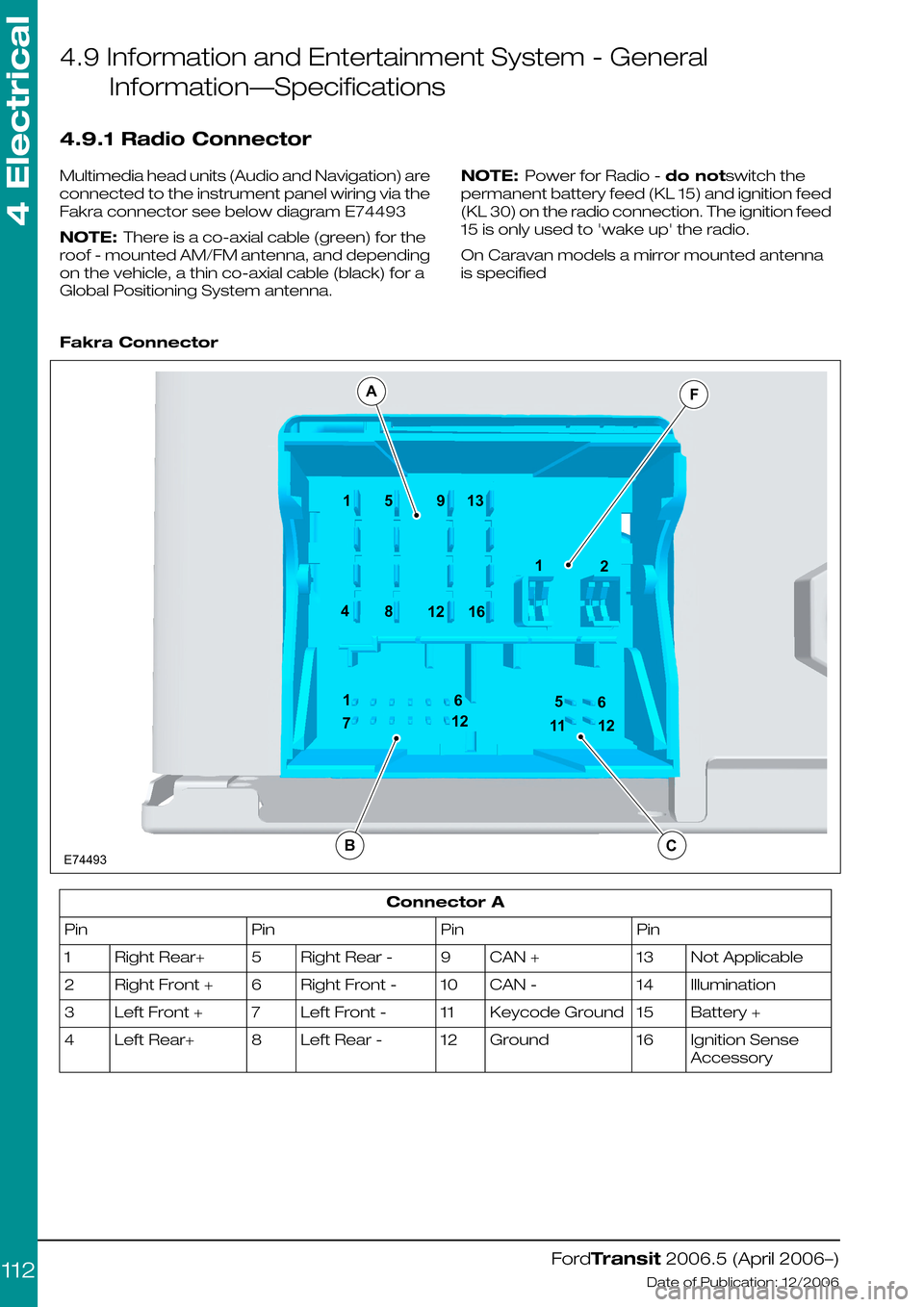
4.9 Information and Entertainment System - General
Information—Specifications
4.9.1 Radio Connector
Multimedia head units (Audio and Navigation) are
connected to the instrument panel wiring via the
Fakra connector see below diagram E74493
NOTE: There is a co-axial cable (green) for the
roof - mounted AM/FM antenna, and depending
on the vehicle, a thin co-axial cable (black) for a
Global Positioning System antenna.
NOTE: Power for Radio - do notswitch the
permanent battery feed (KL 15) and ignition feed
(KL 30) on the radio connection. The ignition feed
15 is only used to 'wake up' the radio.
On Caravan models a mirror mounted antenna
is specified
Fakra Connector
Connector A
PinPinPinPin
Not Applicable13CAN +9Right Rear -5Right Rear+1
Illumination14CAN -10Right Front -6Right Front +2
Battery +15Keycode Ground11Left Front -7Left Front +3
Ignition Sense
Accessory
16Ground12Left Rear -8Left Rear+4
FordTransit 2006.5 (April 2006–)
Date of Publication: 12/2006
4 Electrical
112154891213161216712511612E74493AFCB
Page 113 of 234
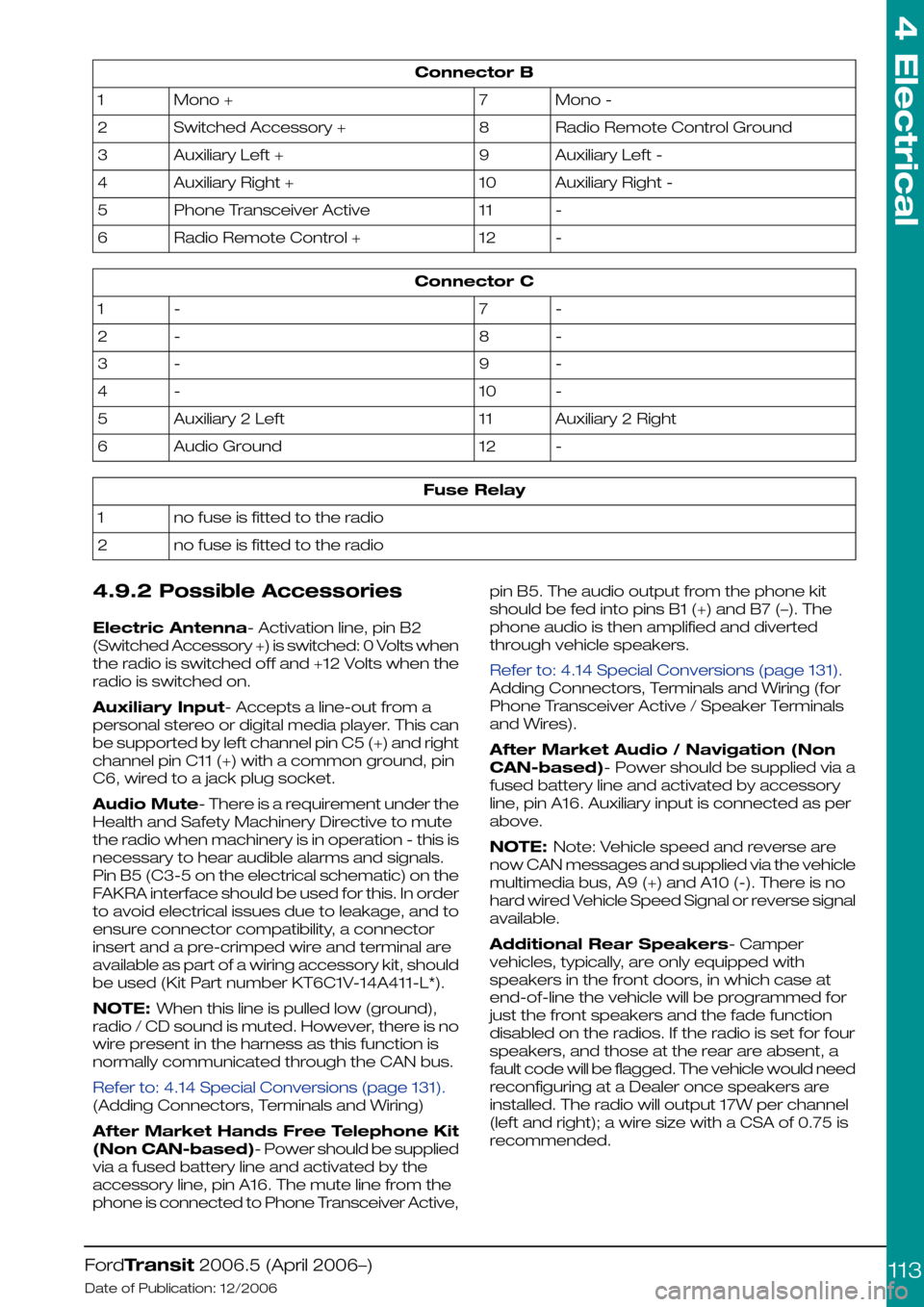
Connector B
Mono -7Mono +1
Radio Remote Control Ground8Switched Accessory +2
Auxiliary Left -9Auxiliary Left +3
Auxiliary Right -10Auxiliary Right +4
-11Phone Transceiver Active5
-12Radio Remote Control +6
Connector C
-7-1
-8-2
-9-3
-10-4
Auxiliary 2 Right11Auxiliary 2 Left5
-12Audio Ground6
Fuse Relay
no fuse is fitted to the radio1
no fuse is fitted to the radio2
4.9.2 Possible Accessories
Electric Antenna- Activation line, pin B2
(Switched Accessory +) is switched: 0 Volts when
the radio is switched off and +12 Volts when the
radio is switched on.
Auxiliary Input- Accepts a line-out from a
personal stereo or digital media player. This can
be supported by left channel pin C5 (+) and right
channel pin C11 (+) with a common ground, pin
C6, wired to a jack plug socket.
Audio Mute- There is a requirement under the
Health and Safety Machinery Directive to mute
the radio when machinery is in operation - this is
necessary to hear audible alarms and signals.
Pin B5 (C3-5 on the electrical schematic) on the
FAKRA interface should be used for this. In order
to avoid electrical issues due to leakage, and to
ensure connector compatibility, a connector
insert and a pre-crimped wire and terminal are
available as part of a wiring accessory kit, should
be used (Kit Part number KT6C1V-14A411-L*).
NOTE: When this line is pulled low (ground),
radio / CD sound is muted. However, there is no
wire present in the harness as this function is
normally communicated through the CAN bus.
Refer to: 4.14 Special Conversions (page 131).
(Adding Connectors, Terminals and Wiring)
After Market Hands Free Telephone Kit
(Non CAN-based)- Power should be supplied
via a fused battery line and activated by the
accessory line, pin A16. The mute line from the
phone is connected to Phone Transceiver Active,
pin B5. The audio output from the phone kit
should be fed into pins B1 (+) and B7 (–). The
phone audio is then amplified and diverted
through vehicle speakers.
Refer to: 4.14 Special Conversions (page 131).
Adding Connectors, Terminals and Wiring (for
Phone Transceiver Active / Speaker Terminals
and Wires).
After Market Audio / Navigation (Non
CAN-based)- Power should be supplied via a
fused battery line and activated by accessory
line, pin A16. Auxiliary input is connected as per
above.
NOTE: Note: Vehicle speed and reverse are
now CAN messages and supplied via the vehicle
multimedia bus, A9 (+) and A10 (-). There is no
hard wired Vehicle Speed Signal or reverse signal
available.
Additional Rear Speakers- Camper
vehicles, typically, are only equipped with
speakers in the front doors, in which case at
end-of-line the vehicle will be programmed for
just the front speakers and the fade function
disabled on the radios. If the radio is set for four
speakers, and those at the rear are absent, a
fault code will be flagged. The vehicle would need
reconfiguring at a Dealer once speakers are
installed. The radio will output 17W per channel
(left and right); a wire size with a CSA of 0.75 is
recommended.
FordTransit 2006.5 (April 2006–)
Date of Publication: 12/2006
4 Electrical
113
Page 141 of 234
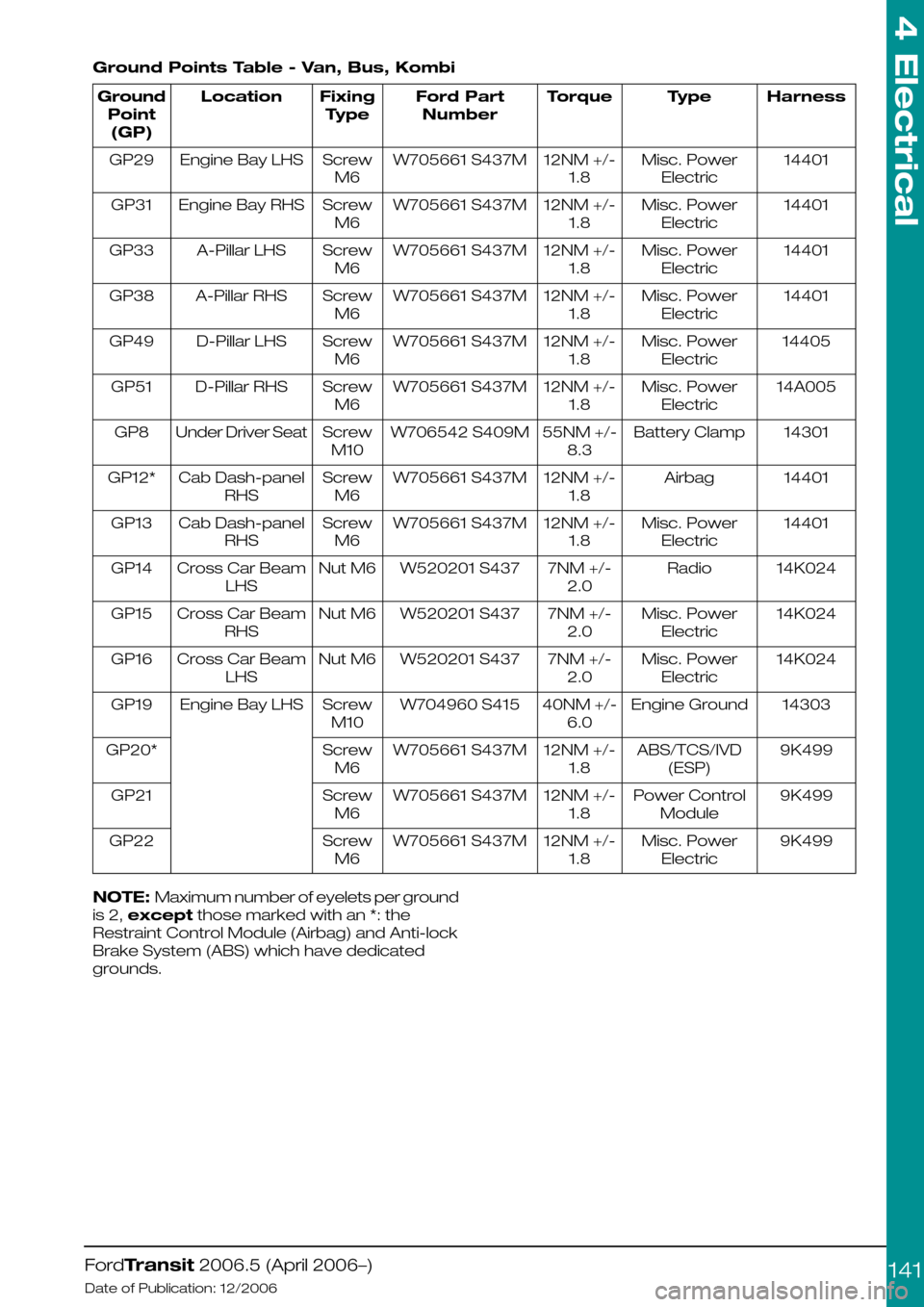
Ground Points Table - Van, Bus, Kombi
HarnessTypeTorqueFord Part
Number
Fixing
Type
LocationGround
Point
(GP)
14401Misc. Power
Electric
12NM +/-
1.8
W705661 S437MScrew
M6
Engine Bay LHSGP29
14401Misc. Power
Electric
12NM +/-
1.8
W705661 S437MScrew
M6
Engine Bay RHSGP31
14401Misc. Power
Electric
12NM +/-
1.8
W705661 S437MScrew
M6
A-Pillar LHSGP33
14401Misc. Power
Electric
12NM +/-
1.8
W705661 S437MScrew
M6
A-Pillar RHSGP38
14405Misc. Power
Electric
12NM +/-
1.8
W705661 S437MScrew
M6
D-Pillar LHSGP49
14A005Misc. Power
Electric
12NM +/-
1.8
W705661 S437MScrew
M6
D-Pillar RHSGP51
14301Battery Clamp55NM +/-
8.3
W706542 S409MScrew
M10
Under Driver SeatGP8
14401Airbag12NM +/-
1.8
W705661 S437MScrew
M6
Cab Dash-panel
RHS
GP12*
14401Misc. Power
Electric
12NM +/-
1.8
W705661 S437MScrew
M6
Cab Dash-panel
RHS
GP13
14K024Radio7NM +/-
2.0
W520201 S437Nut M6Cross Car Beam
LHS
GP14
14K024Misc. Power
Electric
7NM +/-
2.0
W520201 S437Nut M6Cross Car Beam
RHS
GP15
14K024Misc. Power
Electric
7NM +/-
2.0
W520201 S437Nut M6Cross Car Beam
LHS
GP16
14303Engine Ground40NM +/-
6.0
W704960 S415Screw
M10
Engine Bay LHSGP19
9K499ABS/TCS/IVD
(ESP)
12NM +/-
1.8
W705661 S437MScrew
M6
GP20*
9K499Power Control
Module
12NM +/-
1.8
W705661 S437MScrew
M6
GP21
9K499Misc. Power
Electric
12NM +/-
1.8
W705661 S437MScrew
M6
GP22
NOTE: Maximum number of eyelets per ground
is 2, except those marked with an *: the
Restraint Control Module (Airbag) and Anti-lock
Brake System (ABS) which have dedicated
grounds.
FordTransit 2006.5 (April 2006–)
Date of Publication: 12/2006
4 Electrical
141
Page 143 of 234

Ground Points Table - Chassis Cab
HarnessTypeTorqueFord Part
Number
Fixing
Type
LocationGround
Point
(GP)
14401Misc. Power
Electric
12NM +/-
1.8
W705661 S437MScrew
M6
Engine Bay LHSGP29
14401Misc. Power
Electric
12NM +/-
1.8
W705661 S437MScrew
M6
Engine Bay RHSGP31
14401Misc. Power
Electric
12NM +/-
1.8
W705661 S437MScrew
M6
A-Pillar LHSGP33
14401Misc. Power
Electric
12NM +/-
1.8
W705661 S437MScrew
M6
A-Pillar RHSGP38
14301Battery Clamp55NM +/-
8.3
W706542 S409MScrew
M10
Under Driver
Seat
GP8
14401Airbag12NM +/-
1.8
W705661 S437MScrew
M6
Cab Dash-panel
RHS
GP12*
14401Misc. Power
Electric
12NM +/-
1.8
W705661 S437MScrew
M6
Cab Dash-panel
RHS
GP13
14K024Radio7NM +/-
2.0
W520201 S437Nut M6Cross Car Beam
LHS
GP14
14K024Misc. Power
Electric
7NM +/-
2.0
W520201 S437Nut M6Cross Car Beam
RHS
GP15
14K024Misc. Power
Electric
7NM +/-
2.0
W520201 S437Nut M6Cross Car Beam
LHS
GP16
14303Engine Ground40NM +/-
6.0
W704960 S415Screw
M10
Engine Bay LHSGP19
9K499ABS/TCS/IVD
(ESP)
12NM +/-
1.8
W705661 S437MScrew
M6
GP20*
9K499Power Control
Module
12NM +/-
1.8
W705661 S437MScrew
M6
GP21
9K499Misc. Power
Electric
12NM +/-
1.8
W705661 S437MScrew
M6
GP22
NOTE: Maximum number of eyelets per ground
is 2, exceptthose marked with an *: the
Restraint Control Module (Airbag) and Anti-lock
Brake System (ABS) which have dedicated
grounds.
FordTransit 2006.5 (April 2006–)
Date of Publication: 12/2006
4 Electrical
143E773938 E7739431
Page 154 of 234

harness that provides roof-mounted rear turn
indicators, powered via relays. This should be
used in conjunction with SVO fusebox.
3.Chassis cab LED rear lamp cluster
replacement recommendations, especially
turn indicator relay implications – see lighting
load table. Generally the use of LED equivalent
lighting systems reduces the electrical load on
the vehicle; however, special care needs to
be taken with respect to any change to or
addition of turn indicator lights. Depending on
the current requirements of the LED(s)
compared to the bulb it is replacing, a ballast
resistor may be required, if not already
integrated into the LED lamp assembly.
Without this, bulb outage detection for turn
indicators will be affected, which is a legal
requirement.
Additional turn indicators must be powered
through relays (max 300mA), driven by existing
turn lights. The maximum load that the Central
Junction Box can drive is 3 x 21W per side (front,
rear and CAT 6 turn indicators); but even if the
vehicle is not fitted with the CAT 6 lights, the feeds
for these should not be used as the Central
Junction Box would need reconfiguring, which
could have safety as well as functional
implications.
4.Special Vehicle Option beacon switch: wiring
locations, circuit diagrams and max amperage
– see Special Vehicle Option fuse box
schematic (max current is 15A); there is
provision for the Special Vehicle Option beacon
switch in an empty switch location on the
instrument panel.
5.Rear loom connector detail location and supply
details for retro-fit loom extension for
example:- when extending a medium wheel
base, long wheel base or extended frame
overhang, what connectors do they use to
make a plug and play loom extension? – for
chassis cab vehicles, there is an Special
Vehicle Option extension loom for rear lamps
(part number 6C1V-14408-A*). There is not, at
present, a similar loom for Van, Bus and
Kombi's, although the appropriate mating
connector is now tooled, so this would be
possible.
Miscellaneous Systems
Handbrake on - Cluster Warning Light -
Unless the vehicle is specified with options that
drive the handbrake warning light (for example
ESP, Australia market), the components making
up this system are not fitted. We do not
recommend installation of this feature as an
aftermarket addition. There are several reasons
for this:
1.Not all circuits carry the requisite wire as a give
away:
•The wires might be part of the main vehicle
harness (14401) even if not used – for example
camper vehicles are normally ordered with
power mirrors, and the wires will be present
as a give-away.
•The seat pedestal harness (14K076), however,
is vehicle specific – if the handbrake is not part
of the specification, it will not be present or
give-away. This harness would need to be
changed to the compatible part that also
includes the handbrake warning light circuit.
2.The handbrake switch (part number
2F2T-15852-A*) together with its short jumper
harness (6C1T-15K857-A*) would need to be
obtained and fitted.
3.The handbrake warning light is in all clusters,
but unless the vehicle config. parameter
“parking brake switch” is set, the Central
Junction Box will not read this input, and hence
NO CAN message sent to the cluster.
Reconfiguration can only be done at a Ford
Dealer.
NOTE: If a vehicle already has a handbrake
warning light in the cluster, or one is installed as
per the Ford design, it is not possible to utilize the
wire from the handbrake switch as part of an
interlock circuit (this is a pull up resistor input that
provides a wetting current of 20mA – anything in
excess of this, for example through additional
circuitry, will almost certainly damage the Central
Junction Box). If there is no handbrake switch
installed, it would be possible to add one and
utilize this as part of a separate circuit, up to a
maximum current of 500mA through the switch.
Reverse Sensors (Rear Park Aid
Module)- The factory-fit option is a CAN-based
system, but for Van, Bus, and Kombi vehicles
only. Stand-alone systems can be installed (for
example for chassis cab conversions), but would
need to utilize the PTA line of the radio if muting
is required.
Fuel Fired Heater (FFH)- Add FFH: wiring is
only present (give-away) in certain harnesses.
There was an aftermarket kit available for this
system on current Transit, which could probably
be “updated” to suit V347/8.
Fuel Fired Heater (FFH) - Programmable
FFH: this utilizes a timer/control module mounted
to the Instrument Panel, which necessitates
having the correct Instrument Panel harness
fitted. Retrofit of this would be a difficult.
For both systems, the appropriate 6C1T-14K132
harness would be required (suffix -A* for
Programmable FFH, and suffix –B* for Add FFH).
Central Locking
Locking is controlled by the Central Junction Box
module. There is current sensing on certain
locking circuit pins as part of the security system
– if these are tampered with, locking cannot be
guaranteed.
FordTransit 2006.5 (April 2006–)
Date of Publication: 12/2006
4 Electrical
154
Page 231 of 234
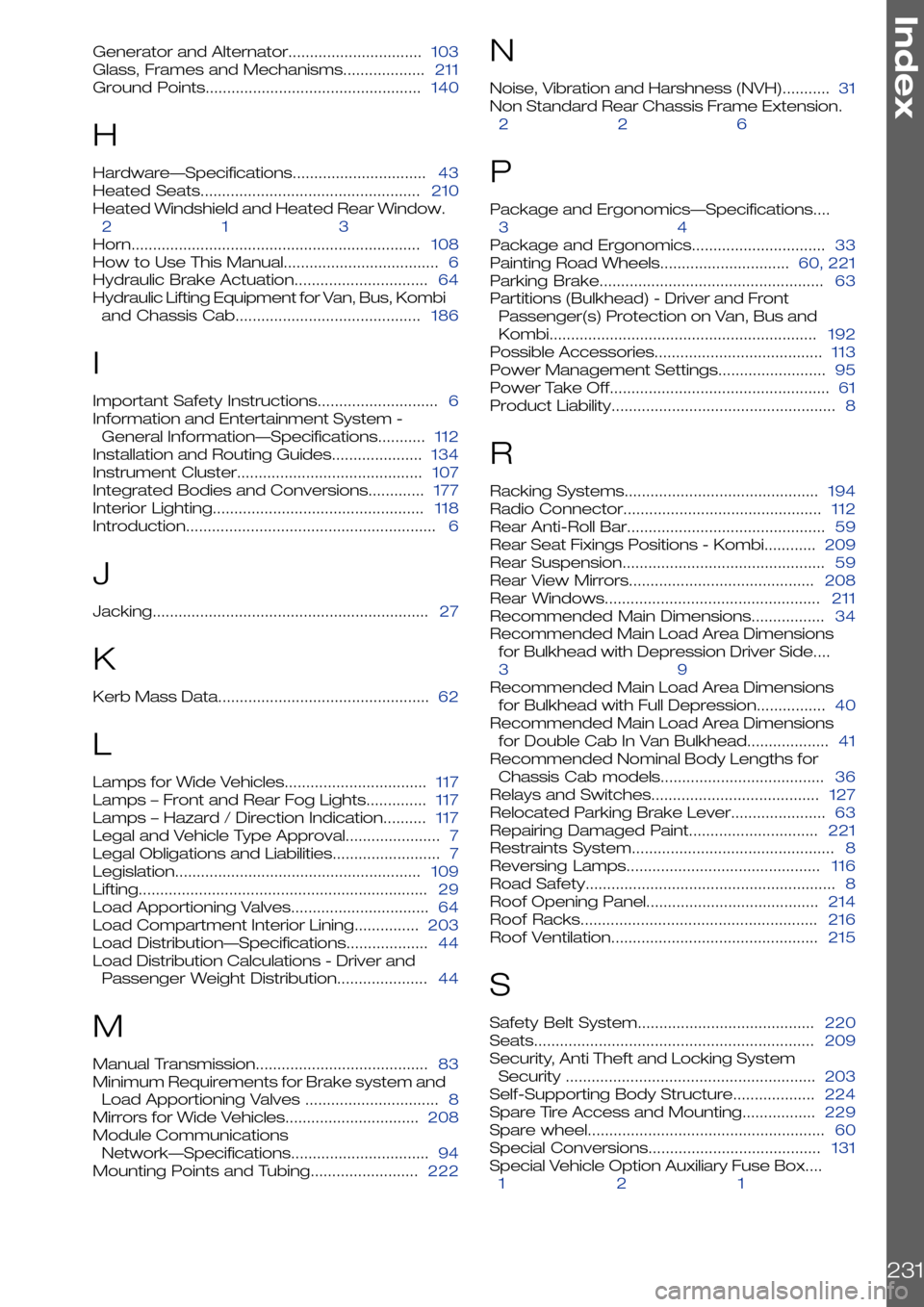
Generator and Alternator...............................103
Glass, Frames and Mechanisms...................211
Ground Points..................................................140
H
Hardware—Specifications...............................43
Heated Seats...................................................210
Heated Windshield and Heated Rear Window.
213
Horn...................................................................108
How to Use This Manual....................................6
Hydraulic Brake Actuation...............................64
Hydraulic Lifting Equipment for Van, Bus, Kombi
and Chassis Cab...........................................186
I
Important Safety Instructions............................6
Information and Entertainment System -
General Information—Specifications...........112
Installation and Routing Guides.....................134
Instrument Cluster...........................................107
Integrated Bodies and Conversions.............177
Interior Lighting.................................................118
Introduction..........................................................6
J
Jacking................................................................27
K
Kerb Mass Data.................................................62
L
Lamps for Wide Vehicles.................................117
Lamps – Front and Rear Fog Lights..............117
Lamps – Hazard / Direction Indication..........117
Legal and Vehicle Type Approval......................7
Legal Obligations and Liabilities.........................7
Legislation.........................................................109
Lifting...................................................................29
Load Apportioning Valves................................64
Load Compartment Interior Lining...............203
Load Distribution—Specifications...................44
Load Distribution Calculations - Driver and
Passenger Weight Distribution.....................44
M
Manual Transmission........................................83
Minimum Requirements for Brake system and
Load Apportioning Valves ...............................8
Mirrors for Wide Vehicles...............................208
Module Communications
Network—Specifications................................94
Mounting Points and Tubing.........................222
N
Noise, Vibration and Harshness (NVH)...........31
Non Standard Rear Chassis Frame Extension.
226
P
Package and Ergonomics—Specifications....
34
Package and Ergonomics...............................33
Painting Road Wheels..............................60, 221
Parking Brake....................................................63
Partitions (Bulkhead) - Driver and Front
Passenger(s) Protection on Van, Bus and
Kombi..............................................................192
Possible Accessories.......................................113
Power Management Settings.........................95
Power Take Off...................................................61
Product Liability....................................................8
R
Racking Systems.............................................194
Radio Connector..............................................112
Rear Anti-Roll Bar..............................................59
Rear Seat Fixings Positions - Kombi............209
Rear Suspension...............................................59
Rear View Mirrors...........................................208
Rear Windows..................................................211
Recommended Main Dimensions.................34
Recommended Main Load Area Dimensions
for Bulkhead with Depression Driver Side....
39
Recommended Main Load Area Dimensions
for Bulkhead with Full Depression................40
Recommended Main Load Area Dimensions
for Double Cab In Van Bulkhead...................41
Recommended Nominal Body Lengths for
Chassis Cab models......................................36
Relays and Switches.......................................127
Relocated Parking Brake Lever......................63
Repairing Damaged Paint..............................221
Restraints System...............................................8
Reversing Lamps.............................................116
Road Safety..........................................................8
Roof Opening Panel........................................214
Roof Racks.......................................................216
Roof Ventilation................................................215
S
Safety Belt System.........................................220
Seats.................................................................209
Security, Anti Theft and Locking System
Security ..........................................................203
Self-Supporting Body Structure...................224
Spare Tire Access and Mounting.................229
Spare wheel.......................................................60
Special Conversions........................................131
Special Vehicle Option Auxiliary Fuse Box....
121
Index
231